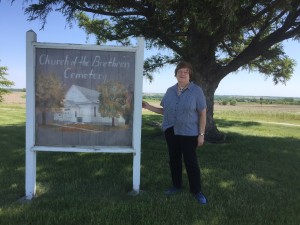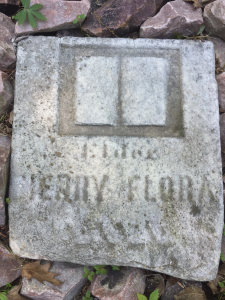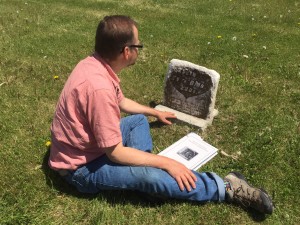Did You Know: Bringing Brethren History Home
Bringing Brethren History Home: ‘A Field Trip’ through Time
By Janis Pyle
 “Sure,” I said, when 2016 District Moderator Rhonda Pittman Gingrich asked me in late January to do a newsletter story about where and how churches were planted in the Northern Plains District. How hard could that be? She mentioned that District Executive Tim-Button-Harrison had some historical documents as a beginning point.
“Sure,” I said, when 2016 District Moderator Rhonda Pittman Gingrich asked me in late January to do a newsletter story about where and how churches were planted in the Northern Plains District. How hard could that be? She mentioned that District Executive Tim-Button-Harrison had some historical documents as a beginning point.
Tim loaned me the documents. I studied them for a month, truly trying to make sense of the assignment. My head was swimming as I went over and over the historical artifacts. Facts about the 32 current Northern Plains churches, all started in different ways. Lists of dates, places, along with families I had never heard about. Minutes from church board meets and district conferences, some sad, a few even chuckle-worthy. Trouble was, using the history books at hand, I couldn’t find a framework to write a credible story. Remorsefully, I turned the books back over to Tim and, as graciously as possible, shared with Rhonda that I had bowed out of the article to be published as part of the District’s 150th anniversary celebration. End of (non) story. Right?
………..
A week later, Tim caught up with me at a committee meeting. He asked if I knew that two Brethren Pioneers were buried within a 20-mile radius of my home in Nevada. He then answered his own question: “Henry Flora and Samuel Garber. “ He asked: “Would you like to go visit their gravesites?” He even offered to take me on a “field trip” to visit them. “Well, okay,” I smiled, knowing he was determined to make Brethren history a living thing for me. Maybe, writing about the trip itself could be the energizing idea that would help me complete a story.
………..
On May 19, Tim picked me up in Nevada, accompanied by a big bag of Brethren books, and headed toward Maxwell. He stopped for a moment in front of the former Maxwell Church of the Brethren. The Maxwell church has been remodeled into a private residence. Tim, ever-curious, said that only time constraints prevented him from knocking and asking for a spur-of-the-moment tour. For me, memories flooded back just seeing the “little white church” again. Sunday morning services. Garden flowers on the altar. All-day quilting sessions. Potluck dinners. Sunday school in the basement. This was the church home of my Brethren grandparents, Joe and Bessie Albright of State Center. My church, too, when I came back to Iowa from Chicago to care for my grandmother in her last years. Harold Smith was more like family serving as our pastor over 40 years. Tim broke into my musings and reminded me that Henry Flora was a founding member and the first minister of the Indian Creek Church, the mother church to Maxwell. I was beginning to see the strong connection between the early church leaders and my own history. And we were on the way to visit Henry Flora’s grave.
………..
The next stop was an impromptu one at the home of John and Carol Beal on Main Street in Maxwell. Their family has faithfully served as caretakers of the Maxwell Church of the Brethren Cemetery, where Henry Flora is buried. They belonged to the Maxwell Church until it closed; our lives overlapped for many years. I had lost touch with them. Carol and I renewed our strong community ties and got caught up on our families as Tim got the exact location of the Henry Flora family gravesite from John. Time melted away as I sat in their living room. Before we left, the Beals said that we should also stop at the Pioneer Cemetery at the south end of Maxwell to look at the community monument that includes Henry Flora’s name.
………..
At the out-of-t he-way Pioneer Cemetery, tucked behind a grain elevator, Tim asked me to read about the Indian Creek church from a bound volume, History of the Northern Plains, Church of the Brethren, 1844-1977, before climbing a small hill to the site. I learned: “It was through the concern and tireless efforts of Henry Flora that Brethren pioneers moving from the East into adjoining counties were sought out. This concern gave rise to the Des Moines Valley (later Ankeny Church of the Brethren), Dallas Center, Panther Creek, Coon River, Harlan, and Prairie City Churches.” (p. 109) A large stately vertical stone listed a score of Maxwell leaders, an indication that Henry Flora and his wife were community as well as church leaders in the town where they lived. Tim discovered an additional marble monument, with an open bible engraved on it, with Henry Flora’s name. Tim pulled the weeds around it. I stood for a moment in the morning sun in gratitude for the Flora family’s devotion.
he-way Pioneer Cemetery, tucked behind a grain elevator, Tim asked me to read about the Indian Creek church from a bound volume, History of the Northern Plains, Church of the Brethren, 1844-1977, before climbing a small hill to the site. I learned: “It was through the concern and tireless efforts of Henry Flora that Brethren pioneers moving from the East into adjoining counties were sought out. This concern gave rise to the Des Moines Valley (later Ankeny Church of the Brethren), Dallas Center, Panther Creek, Coon River, Harlan, and Prairie City Churches.” (p. 109) A large stately vertical stone listed a score of Maxwell leaders, an indication that Henry Flora and his wife were community as well as church leaders in the town where they lived. Tim discovered an additional marble monument, with an open bible engraved on it, with Henry Flora’s name. Tim pulled the weeds around it. I stood for a moment in the morning sun in gratitude for the Flora family’s devotion.
………..
We travelled south of town to the neat and picturesque Maxwell Church of the Brethren Cemetery where Flora was laid to rest. I wondered aloud to Tim about how the early churches came into being. He referred me back to the History of the Northern Plains. I read about how the Des Moines Valley Church was established around 1868: “…the first meetings were held in early country schoolhouses or in homes. Sometimes ministers from a great distance would ride horseback or come by team and buggy to assist and give encouragement to the group. Some of these early minsters were George Baker, Michael Garber, John Garber, and Henry Flora.” (p. 83) Tim reminded me of the perseverance of the early leaders, noting the section on the Harlan (Botany) Church: “The first minsters’ visit to Shelby County was made in June 1863 by Elder Flora (Indian Creek) and J.D. Haughtelin (Coon River). The first baptismal service was on Saturday afternoon of that visit, and the first Love Feast was held that evening. A series of meetings was held in January, 1865, by J.D. Haughtelin and Wm. Hillary. ‘A number of persons were converted, and were baptized in ice water, in zero weather, without any inconvenience.’” (p. 155) We found the exact site for Henry Flora’s family. I lingered to visit the graves of so many persons connected with my Maxwell church, including John Beal’s parents. I was mindful that without the vision and hardiness of the early leaders there would be no Maxwell Church.
………..
 “Now, on to ‘visit’ Samuel Garber!” Tim sing-songed, as we headed east out of Maxwell. Using a 19th Century Iowa plat map (on his smartphone!), he navigated gravel back roads to the small Malta Cemetery on a hilltop southeast of State Center. Samuel Garber (1806-1874) was a minister, born in Virginia, who spent his last years few years in Iowa. He was best known, Tim said, for being one of the first Brethren abolitionists. He told me that a full account of Garber’s’ brush with the law on his anti-slavery stance appears on the first page of The Brethren Encyclopedia, which he had happened to bring along. The other reference book at hand was The Tie That Binds the Samuel Garber Family, a gift to the Northern Plains District from compiler and relative Linda Thompson. She wrote about the joy of discovering Samuel Garber’s tombstone at this cemetery in 2004: “The top part of the stone, when uncovered, revealed the engraving of an open book, most likely an image of the Bible, at the top of the stone. What a testimony that he who had proclaimed the gospel to others for so many years would be known by future generations as a man who valued the Word of God. The tie that bound his family together was the scarlet thread of the creation–redemption story that is woven throughout the Bible.” (p. 74) A picture of that grave stone was in the family history. Tim discovered that it was now in two pieces, each erected separately in the cemetery. The value of Samuel Garber’s story to my life was one of encouraging me to keep being engaged in the issues of the day, even when it involves being at odds with the authorities. I took note that one commonality between Samuel Garber and Henry Flora was the same open bible engraved on their tombstones.
“Now, on to ‘visit’ Samuel Garber!” Tim sing-songed, as we headed east out of Maxwell. Using a 19th Century Iowa plat map (on his smartphone!), he navigated gravel back roads to the small Malta Cemetery on a hilltop southeast of State Center. Samuel Garber (1806-1874) was a minister, born in Virginia, who spent his last years few years in Iowa. He was best known, Tim said, for being one of the first Brethren abolitionists. He told me that a full account of Garber’s’ brush with the law on his anti-slavery stance appears on the first page of The Brethren Encyclopedia, which he had happened to bring along. The other reference book at hand was The Tie That Binds the Samuel Garber Family, a gift to the Northern Plains District from compiler and relative Linda Thompson. She wrote about the joy of discovering Samuel Garber’s tombstone at this cemetery in 2004: “The top part of the stone, when uncovered, revealed the engraving of an open book, most likely an image of the Bible, at the top of the stone. What a testimony that he who had proclaimed the gospel to others for so many years would be known by future generations as a man who valued the Word of God. The tie that bound his family together was the scarlet thread of the creation–redemption story that is woven throughout the Bible.” (p. 74) A picture of that grave stone was in the family history. Tim discovered that it was now in two pieces, each erected separately in the cemetery. The value of Samuel Garber’s story to my life was one of encouraging me to keep being engaged in the issues of the day, even when it involves being at odds with the authorities. I took note that one commonality between Samuel Garber and Henry Flora was the same open bible engraved on their tombstones.
………..
When Tim was driving me back to Nevada, I noticed that we were just a mile from where my Brethren grandparents lived. Could we drive past my family’s farm? I asked. He said yes, of course. We drove slowly by the large white farmhouse, evergreens still lining the driveway. Tim saw that the current owner was in the yard. Tim’s gift of social fearlessness once again kicked into high gear. “Do you want to talk with him?” he asked. Yes! My “field trip” would include a close-up view of the fields of my childhood! I ended up not only seeing the outbuildings but also touring the whole remodeled home! I hadn’t been inside the home for 25 years! At first, the side trip seemed incongruent to my primary mission of tracking down Brethren pioneer church leaders, but this detour seemed connected, as I was reminded of the source of the stable, well-grounded life that my grandparents built. Their base was a Brethren church community, one founded by those early church leaders I had just encountered. What would my family have done without the Maxwell Church? My grandfather Joe died in 1981, and my grandmother Bessie didn’t drive. Jimmie (John’s father) and Naomi Beal picked up her and companion Sadie every week for church service. Other couples helped her gather groceries and get to Tuesday Ladies’ Aid. For almost 10 more years, my grandmother was able to live independently, keeping the farm in the family for us to enjoy.
………..
I mused later to Tim that my “field trip” was a full circle tour. I learned how the central Iowa churches had been planted, and then realized the ripple effects of one of those churches, the Maxwell Church, on my family’s life. Surely, the most lasting legacy of church planters, not contained in the history books, is the one I felt that day, the mutual care and concern among the members that lives on and extends to new generations.
#######

No comments yet
Comments are closed